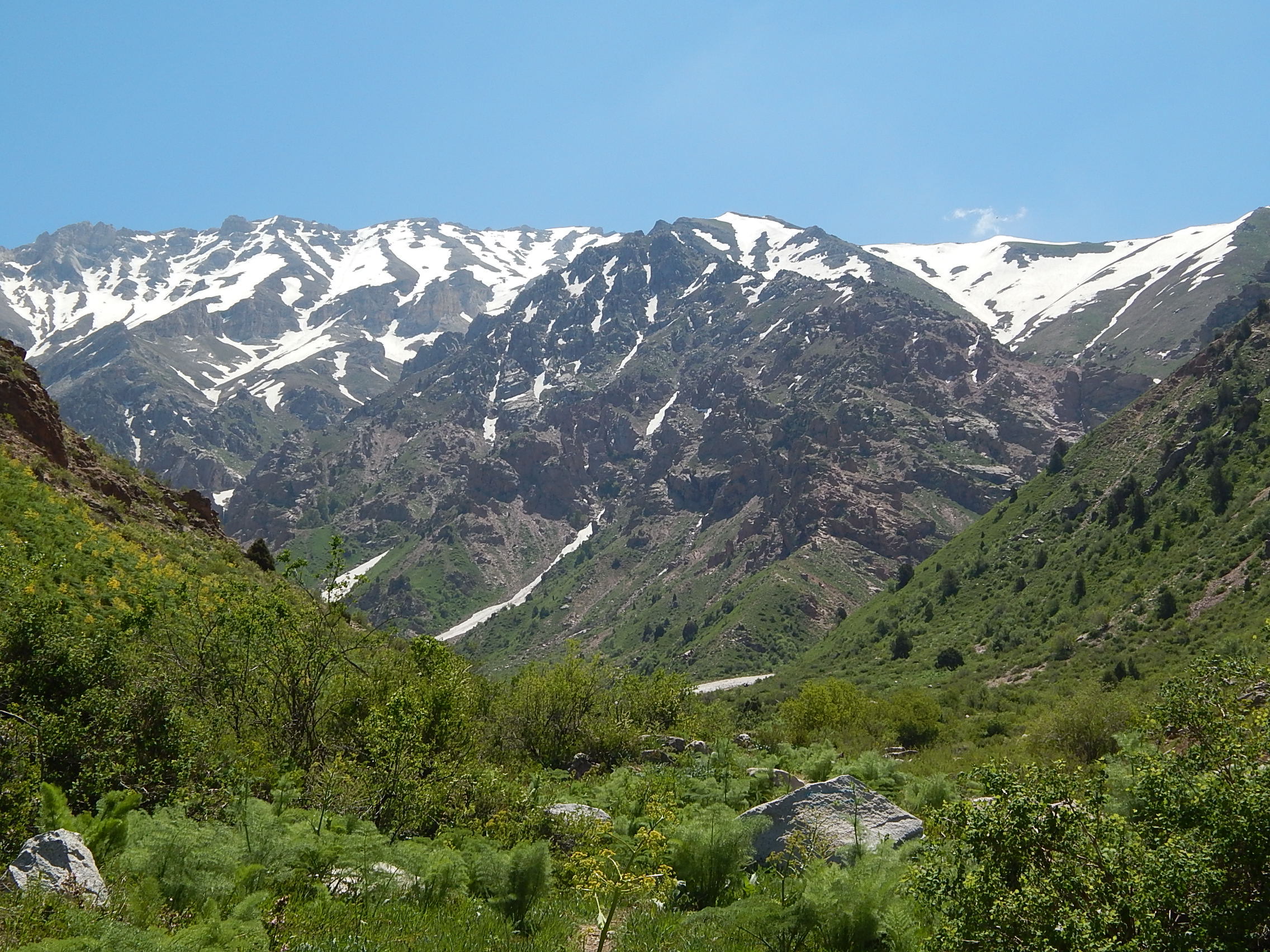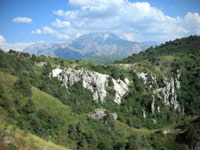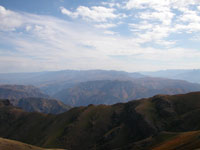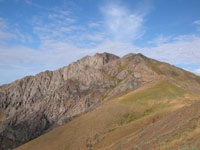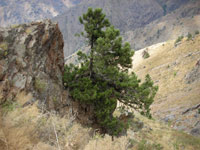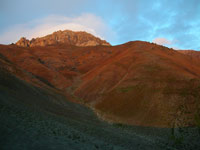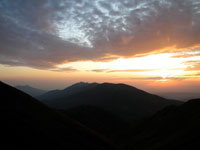Post Views: 124
Uzbekistan Mountain Climbing

Uzbekistan Mountain Climbing (Mountaineering) – Ascending mountains
Gelon plus climbing the Hazrat Sultan holy peak

Coordinates: 39°04’N 67°27’E
Gelon is a settlement in the Shakhrisabz district of the Kashkadarya region of the Republic of Uzbekistan.
The village was founded in 1305. The inhabitants of the village still keep the ancient customs and way of life. Until mid-2018, foreign tourists could not visit this village due to the special border regime.
Geography
Gelon is located in the southern part of Uzbekistan in Kashkadarya, on the western slopes of the Pamir-Alai mountains.
The territory is located on the border of Uzbekistan and Tajikistan, 80 kilometers from Shakhrisabz. The village is surrounded on all sides by high mountains, reaching heights of more than 4,000 meters in the east. This is one of the highest mountain villages in Uzbekistan. It is not easy to get here along a difficult but picturesque mountain dirt road with numerous serpentines.
Climate
The climate is continental, dry, subtropical in places.
Population
The population of the village is 5834 people (2019). The overwhelming majority of people here are Tajiks.
Interesting facts
Gelon is located at an altitude of 2600 meters above sea level. In the vicinity of the village there are practically no flat plots of land where a tractor could be used, and the peasants are forced to cultivate potato fields on steep mountain slopes reaching 40 degrees, using a simple plow pulled by a pair of bulls or donkeys. Orchards are also grown on steep slopes and in river gorges.
Peculiarities of local life in the village of Gelon
A special pride of the inhabitants of the village is an extensive irrigation network of artificial canals laid along the slopes of the mountains for tens of kilometers. The most famous mountain potatoes in Uzbekistan grow here. Especially exotic is the central part of the village with old houses and narrow streets.
The second floor of the house here is residential, and the first floor is used for keeping livestock. The same architecture is used in Tibet and in the highlands of Nepal. In the village, tourists can get acquainted with the life of the inhabitants, take a walk for 1-3 days in the picturesque surroundings, as well as in the neighboring villages Kul, Shut, Sarchashma.
A river of the same name flows through Gelon. In the village there are interesting local artists, musicians who actively take part in various events, weddings.
Gelon is the oldest settlement in the region and is considered the richest in the Kashkadarya region. The main activities in Gelon are planting potatoes, cultivating watermelons, fruits and raising livestock. All residents of the village are Muslims, they also hold weddings in accordance with Muslim Sharia rituals. Girls get married at the age of 18. A resident of Gelon is obliged to keep his wife clean and safe, to read sacred prayers, not to drink alcohol and not to smoke. At the beginning of the 20th century, when the revolution began, the Basmachi movement was developed in the village.
At the moment, the Gelon settlement has the largest number of centenarians. Its inhabitants reach 85-90 years. Here you can easily see a man who is over 85, and he will be the embodiment of health and strength.
Tourism
Not far from the village of Gelon is the holy mountain “Khazrati Sultan”, where thousands of tourists come to pray (Not to be confused with the highest point of Uzbekistan (4643 m.), Which is located on the Gissar Range in the Sariasiya district of the Surkhandarya region, on the Uzbek-Tajik border. In 1964 the first ascent of this mountain was made, it was given the name after the XXII Congress of the Central Committee of the CPSU. But there are no documents left from that expedition, just as no documents from other expeditions were found. It is known for certain that Uzbek climbers climbed this peak in 2010. Approaches to the peak from Uzbekistan are very difficult, so many expeditions tried to climb the mountain from the side of Tajikistan, the village of Sarytag, near Iskandarkul Lake).
Also, being in the village, you can visit one of the most spectacular and abundant waterfalls in Uzbekistan, the 40-meter waterfall “Suvtushar”. On the way to the village, guests pass by the Hissar reservoir, which is a popular place among tourists.
The best time to visit the region is from 15 June to 30 September.

Program
1 day Samarkand – Shakhrisabz – Gelon village.
Meeting in Samarkand. Transfer to Shakhrisabz. City tour. Departure to Gelon. On the way, sightseeing of the Gissarak reservoir, then moving along the picturesque gorge of the Oksu River to the village of Gelon. Accommodation in a national house at an altitude of 2200 m. Walking around the village, visiting the house of the artist Muhammadi, the central mosque and teahouse. Visit to the village museum.
Travel time from Samarkand to Gelon village 4-5 hours, 175 km.
Day 2 Gelon village – Mukhbel pass.
Departure through the Urtabel pass (2466 m.) to the Kul village, then through the Serketartar pass (2537 m.), Baturbai gorge and Mirny pass (3150 m.), to the Khonako gorge and ascent under the Mukhbel pass. Setting up a camp at an altitude of 3100 m, accommodation in tents.
Travel time 3 – 4 hours, 35 km.
Day 3 Peak Hazrat Sultan – the village of Gelon.
Early in the morning ascent to the top of Hazrat Sultan (4083 m.)
Hazrat Sultan is a place of pilgrimage for Muslims. This shrine is known far beyond the borders of Uzbekistan. The grave of Hazrat Dovud is located at the very top. Here you will learn about the life and exploits of Hazrat Dovud. A magnificent panorama of the Gissar and Zeravshan mountains opens from the top. Walking time 5-6 hours, 12 km: +/-1000 m. Departure to Gelon village. Accommodation in the national house 2200 m.
Travel time 3 hours, 35 km.
Day 4 Gelan village – Shakhrisabz – Samarkand.
Departure to Samarkand. Travel time 4 – 5 hours, 175 km.
____________________________________________________________________________
Contact information
https://t.me/ClimberCA – telegram
WhatsApp / Viber +7966 065-53-44
e-mail – your@climberca.com
Tour price:
Number of people & price per person
1 – $680
2 – $570
3 – $520
4 – $475
5 – $440
6 – $420
7 – $400
The tour price includes:
– Meeting and farewell.
– Transport according to the program. / NIVA, NIVA CHEVROLET, JEEP or UAZ. 3 people in 1 car/
– Accommodation according to the program.
– Full board meals.
– Services of an interpreter guide / English or German /
– Entrance tickets to historical monuments in Shakhrisabzs.
– Museum, artist and blacksmith visit, local folklore.
– Mountain guide services.
– Cooking services, kitchen utensils, gas.
The tour price does not include:
Border pass, to visit the border area – $ 30.
Traverse of three peaks: Rock climbing, Free climbing, Scrambling

Day 1 Transfer from Tashkent to Beldersay (88 km, 2 hrs.). Walking along the gorge of the Beldersay River to the Chet-Kumbel Pass (1880 m). Overnight stay in tents on the picturesque glade. Camp 1.
Day 2 Walking along the good path to the upper Beldersay river. Ascend to the Kumbel Pass (2550 m). Climbing along the southern slopes to the Greater Chimgan Peak (3,309 m), descent to the Komsomolec Pass (2700 m). Camp 2.
Day 3 Climbing to the Kichkina (2879 m) and the Aukashka (3099 m) Peaks. Magnificent landscapes and challenge rock climbing. Return to Camp 2
Day 4 Descending from the Komsomolec pass to the gorge of the Mazarsay River. Hiking to the place called “Vodoprovod”. Camp 3 near the spring.
Day 5 Descending to the gorge of Gulkamsay river. Visiting the Gulkam canyon. In the afternoon passing through the Pesocniy pass (1,832 m) to the valley of Chimgansay river. Collected by car. Return to Tashkent.
See the map …
Trek Price Per Person
Individual: US$ 600
2 Pax: US$ 335
3 Pax : US$ 270
4 Pax: US$ 217
5 Pax: US$ 200
Transportation Tashkent-Chingan-Tashkent isn’t Included; Personal Equipment isn’t Included. Mountain guide service – included. Guide/Climber Ratio: 1:5 maximum limit. The rent of the tents is included for all period of trek. Food (survival ration), kitchen and climbing gears – included. Porter service is available for an additional payment. The price does not include: personal travel insurance; personal equipment, alcohol, personal expenses.
Uzbekistan mountains
The mountains of Uzbekistan enter in structure of Tyan-Shan and Alay mountain systems. On territory turn the western spurs of Tyan-Shan and Gissar-Alay mountain system. To south and west they gradually lower and turn to plains.
Internal (tectonic) power of Earth formed folds grown the powerful ranges of mountains.
The mountains and foothills with brook relief, located in east and south-east part of Uzbekistan, where they unite with powerful mountain
deep brook massive on territory of Kirgizya and Tadjikistan. Mainly this Ugam, Pskem, Chatkal, Kuramin ranges and their western and south-western spurs, concerning to Western Tyan-Shan system and Turkestan, Zerafshan and Gissar ranges with their continuous on south-western – Babatag and Kugintangtau ranges, concerning to Gissar-Alay system.
Entering on territory of Uzbekistan its spurs formed radiating bundle of mountain chains, constantly less in north-western and south-western directions. The character example is Karjantau, Maygashkan and Surenata ranges in western Tyan-Shan system and Nuratau, Aktau and Kuratau ranges and Karatepa and Ziadin-Zirabulak mountains, being the last of Pamir-Alay.
Entering in Western Tyan-Shan system the mountain ranges (Karjantau, Ugam, Pskem, Chatkal, Kuramin) began from Talass Alatau (on border with Kirgizstan), further as fan radiate from here and continuos to north-east to south-west.
The more high point of Talass Alatau is mountain Manas (4482m). The high point of Chatkal range on territory of Uzbekistan – Greater
Chimgan peak (3309 m). Between Chatkal and Kuramin ranges located Akhangaran valley.
The apexes of Western Tyan-Shan covered with snow and glaciers.
The Chatkal and Kuramin ranges border on north with Fergana valley. From east she borders with Fergana range, from south with Alay and Turkestan ranges. To north-west from Turkestan range raises the Malguzar range, to south-west Chumkartau range. Only the north slopes of Chumkartau entering on territory of Uzbekistan. The valley of Sanzar river separate the Malguzar mountains from Nuratau mountains. The weak point in this valley named Tamerlan gates.
The Nuratau mountains stretch on 180 km. Their north slope is steep, the south slope is gently sloping. The high point of North part of Nuratau mountains is Khayatbashi apex (2165 m). The south part of Nuratau mountains consists from separate apexes (Aktau, Karatau, Karagatau, Gabduntau).
On the south and as parallel to Turkestan range located Zarafshan range. With self eastern part he entering on territory of Tadjikistan. On south from Zarafshan range located Gissar range and his south-western spurs (Yakkobag, Surkhantau, Kugikantau, Baysuntau, Chakgarand other). Here located the highest point of Uzbekistan – the Khazret Sultan (4643 m).
In western part of Gissar range are two glaciers – Batirbay and Severcev. On south of Uzbekistan along of border with Tadjikistan located Babatag range. The high point – Zarkasa (2292 m). The main features of orography of Uzbekistan connected with features of geological structure of above-mentioned the mountain systems.
This bond found expression in these, that between mountain ranges located spacious foothill and intermountain depressions, the large from which is Tashkent-Golodnosteppe, Fergana Zarafshan, Kashkadarya and Surkhandarya.
Uzbekistan Mountains near to Tashkent
Chimgan Mountains
The Chimgan Mountains are invariably attractive for mountaineers. The wide variety of Chimgan and its surroundings allows the activity in all kinds of mountaineering and landscape tourism. Mountains (Small and Greater Chimgan Peaks – 3,309 m) of Chatkal range, plateaus, the Black Waterfall (40 m) at the lower part of Greater Chimgan Peak, Gulkam waterfalls, attract a lot of tourists from Uzbekistan and abroad.
Ugam & Karjantau ridges
Another attractive place for mountaineering is situated on Ugam ridge and on the southern; slopes of the Karjantau ridge of the Western
Tyan-Shan system. There are following natural sites, which are of interest of mountaineers in area of Ugam & Karjantau ridges:
- Peak Mingbulak(2,628 m) – the highest peak of the Karjantau ridge.
- Qizilsuv waterfalls– the pictorial cascades that flow at the sinuous river gorges of Qizilsuv Mountain River.
- Loquacious caveis located on plateau Ghiza, 20 km from village Humsan, in a funnel-shaped hollow. On the bottom of the hollow, in the exposure of grey limestone, there is a 1×1 m rectangular aperture transforming to a 1.5 m high sloping tunnel. Its floor is covered with
lumps, ceiling being arcaded. This tunnel is 20 m long and leads to the inner larger part of the cave. A ladder is needed in order to proceed
into the cave as there is a 6 m high prominence. Then the floor levels out, height reaching 20-30 m. The cave is so named due to a treamlet flowing through it.
- Arkutsay– exposure of loess stratum. The site is 3 km west of Humsan, on the right bank of the Ugam River. Section of the formation represents the wall of a small landslide breakaway and is a stratum of interstratifying loess-like loams of Quaternary and fossil soils horizons. The section is unique as it exposes more than 80 m thick deposition of rocks.
- Kyrk-Kokyl waterfall(in Uzbek “Kyrk-Kokyl” means 40 plaits) – pictorial waterfall at Pustonlyk – confluent of Ugam River, 9 km from Humsan village.






